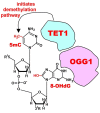Bile acids as carcinogens in the colon and at other sites in the gastrointestinal system
- PMID: 36408538
- PMCID: PMC9989147
- DOI: 10.1177/15353702221131858
Bile acids as carcinogens in the colon and at other sites in the gastrointestinal system
Abstract
Colon cancer incidence is associated with a high-fat diet. Such a diet is linked to elevated levels of bile acids in the gastrointestinal system and the circulation. Secondary bile acids are produced by microorganisms present at high concentrations in the colon. Recent prospective studies and a retrospective study in humans associate high circulating blood levels of secondary bile acids with increased risk of colon cancer. Feeding mice a diet containing a secondary bile acid, so their feces have the bile acid at a level comparable to that in the feces of humans on a high-fat diet, also causes colon cancer in the mice. Studies using human cells grown in culture illuminate some mechanisms by which bile acids cause cancer. In human cells, bile acids cause oxidative stress leading to oxidative DNA damage. Increased DNA damage increases the occurrence of mutations and epimutations, some of which provide a cellular growth advantage such as apoptosis resistance. Cells with such mutations/epimutations increase by natural selection. Apoptosis, or programmed cell death, is a beneficial process that eliminates cells with unrepaired DNA damage, whereas apoptosis-resistant cells are able to survive DNA damage using inaccurate repair processes. This results in apoptosis-resistant cells having more frequent mutations/epimutations, some of which are carcinogenic. The experiments on cultured human cells have provided a basis for understanding at the molecular level the human studies that recently reported an association of bile acids with colon cancer, and the mouse studies showing directly that bile acids cause colon cancer. Similar, but more limited, findings of an association of dietary bile acids with other cancers of the gastrointestinal system suggest that understanding the role of bile acids in colon carcinogenesis may contribute to understanding carcinogenesis in other organs.
Keywords: Carcinogenesis; DNA damage; apoptosis; gastrointestinal cancer; oxidative stress.
Conflict of interest statement
The author(s) declared no potential conflicts of interest with respect to the research, authorship, and/or publication of this article.
Figures



Similar articles
-
Bile acids as carcinogens in human gastrointestinal cancers.Mutat Res. 2005 Jan;589(1):47-65. doi: 10.1016/j.mrrev.2004.08.001. Mutat Res. 2005. PMID: 15652226 Review.
-
Effect of amount and types of dietary fat on intestinal bacterial 7 alpha-dehydroxylase and phosphatidylinositol-specific phospholipase C and colonic mucosal diacylglycerol kinase and PKC activities during stages of colon tumor promotion.Cancer Res. 1996 May 15;56(10):2314-20. Cancer Res. 1996. PMID: 8625306
-
Bile acids in the colon, from healthy to cytotoxic molecules.Toxicol In Vitro. 2013 Mar;27(2):964-77. doi: 10.1016/j.tiv.2012.12.020. Epub 2012 Dec 27. Toxicol In Vitro. 2013. PMID: 23274766 Review.
-
Bile acids, but not neutral sterols, are tumor promoters in the colon in man and in rodents.Environ Health Perspect. 1983 Apr;50:101-7. doi: 10.1289/ehp.8350101. Environ Health Perspect. 1983. PMID: 6307678 Free PMC article.
-
Role of bile acids and neutral sterols in familial cancer syndromes of the colon.Dis Colon Rectum. 1983 Sep;26(9):629-32. doi: 10.1007/BF02552982. Dis Colon Rectum. 1983. PMID: 6872797
Cited by
-
Plant-Based Diet and Risk of Iron-deficiency Anemia. A Review of the Current Evidence and Implications for Preventive Strategies.Curr Nutr Rep. 2025 Jun 18;14(1):81. doi: 10.1007/s13668-025-00671-y. Curr Nutr Rep. 2025. PMID: 40528105 Free PMC article. Review.
-
Bile Acid Diarrhea Is Associated With an Increased Incidence of Gastrointestinal Cancers.Am J Gastroenterol. 2024 Oct 1;119(10):2107-2113. doi: 10.14309/ajg.0000000000002859. Epub 2024 May 8. Am J Gastroenterol. 2024. PMID: 38717021 Free PMC article.
-
Impact of Metabolites from Foodborne Pathogens on Cancer.Foods. 2024 Dec 1;13(23):3886. doi: 10.3390/foods13233886. Foods. 2024. PMID: 39682958 Free PMC article. Review.
-
Pangenome Analysis of Clostridium scindens: A Collection of Diverse Bile Acid- and Steroid-Metabolizing Commensal Gut Bacterial Strains.Microorganisms. 2025 Apr 9;13(4):857. doi: 10.3390/microorganisms13040857. Microorganisms. 2025. PMID: 40284693 Free PMC article.
-
Another renaissance for bile acid gastrointestinal microbiology.Nat Rev Gastroenterol Hepatol. 2024 May;21(5):348-364. doi: 10.1038/s41575-024-00896-2. Epub 2024 Feb 21. Nat Rev Gastroenterol Hepatol. 2024. PMID: 38383804 Free PMC article. Review.
References
-
- American Cancer Society Cancer Facts Figures 2022 . Atlanta, GA: American Cancer Society, 2022
-
- Sung H, Ferlay J, Siegel RL, Laversanne M, Soerjomataram I, Jemal A, Bray F. Global cancer statistics 2020: GLOBOCAN estimates of incidence and mortality worldwide for 36 cancers in 185 countries. CA Cancer J Clin 2021;71:209–49 - PubMed
-
- Reddy BS. Role of bile metabolites in colon carcinogenesis. Cancer 1975;36:2401–6 - PubMed
-
- Hill MJ. The role of colon anaerobes in the metabolism of bile acids and steroids, and its relation to colon cancer. Cancer 1975;36:2387–400 - PubMed
-
- Nagengast FM, Grubben MJ, van Munster IP. Role of bile acids in colorectal carcinogenesis. Eur J Cancer 1995;31A:1067–70 - PubMed
Publication types
MeSH terms
Substances
LinkOut - more resources
Full Text Sources

